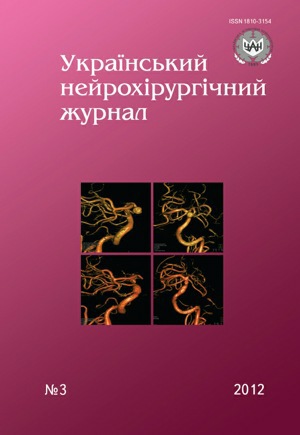Successful treatment of severe penetrating cranio-cerebral trauma, associated with brain compression
DOI:
https://doi.org/10.25305/unj.60851Keywords:
severe penetrating cranio-cerebral trauma, nasal liquorrhea, skull base fracture, decompressive craniectomy, intracranial hypertensionAbstract
Introduction. Surgical treatment of severe penetrating cranio-cerebral trauma (SCCT) is a complex problem. Basal liquorrhea (BL) at skull base fractures causes high risk of purulent-septic complications. Conservative BL treatment at scull base fractures with many splinters sometimes ineffective. Along with intracranial hypertensia elimination at decompressive craniectomy (DC) performance and mass-centers removing, during primary operation plastics of scull base defects is needed.
Methods. In two patients with SCCT during one operation DC and mass-centers removing were performed stage-by-stage, plastics of scull base defects, using autotissue on a feeding stalk and haemostatic sponge with fibrin-trombin covering “Takhokomb” were used. For intracranial hypertension control during operation and after it continuous monitoring of intracranial pressure was used.
Results. The use of proposed approach to SCCT treatment allowed to provide control of intracranial pressure after operation and liquorrhea termination, to avoid intracranial purulent-septic complications.
Conclusions. Stage-by-stage DC, mass-centers removing and removal and skull base defects plastics during primary operation — is an effective method of surgical treatment of SCCT, combined with brain compression, scull base fractures and profuse nasal liquorrhea.
References
1. Guidelines for the Surgical Management of Traumatic Brain Injury. Brain Trauma Foundation, American Association of Neurological Surgeons. Neurosurgery. 2006;58(3) suppl.2:46.
2. Konovalov AN, Likhterman L B, Potapov AA. Klinicheskoye rukovodstvo po cherepno-mozgovoy travme [Clinical guidelines for traumatic brain injury]. Editor by Konovalov AN. Mocsow: ANTIDOR; 1998. Russian.
3. Schmidek HH, Roberts DW. Operative neurosurgical techniques. Philadelphia:Saunders; 2006.
4. Greenberg MS. Handbook of neurosurgery. New York; Stuttgart: Thieme; 2006.
5. American Association of Neuroscience Nurses. Care of the patient undergoing intracranial pressure monitoring/external ventricular drainage or lumbar drainage. Glenview (IL): American Association of Neuroscience Nurses; 2011.
6. Whitfield PC, editor. Head injury. A multidisciplinary approach. Cambridge: Univers. Press; 2009.
7. Potapov AA, Likhterman LB, Zelman VL, editors. Dokazatelnaya neyrotravmatologiya [Evidence neurotraumatology]. Moscow: NII neyrokhirurgii im. N.N. Burdenko RAMN; 2003. Russian.
8. Hardt N. Neurocranial injuries in craniofacial, skullbase fractures. In: Hardt N, Kuttenberger J. Craniofacial Trauma. Diagnosis and Management. Philadelphia: Springer; 2010.
Downloads
Published
How to Cite
Issue
Section
License
Copyright (c) 2012 Andriy Sirko, Grigoriy Pilipenko

This work is licensed under a Creative Commons Attribution 4.0 International License.
Ukrainian Neurosurgical Journal abides by the CREATIVE COMMONS copyright rights and permissions for open access journals.
Authors, who are published in this Journal, agree to the following conditions:
1. The authors reserve the right to authorship of the work and pass the first publication right of this work to the Journal under the terms of Creative Commons Attribution License, which allows others to freely distribute the published research with the obligatory reference to the authors of the original work and the first publication of the work in this Journal.
2. The authors have the right to conclude separate supplement agreements that relate to non-exclusive work distribution in the form of which it has been published by the Journal (for example, to upload the work to the online storage of the Journal or publish it as part of a monograph), provided that the reference to the first publication of the work in this Journal is included.









